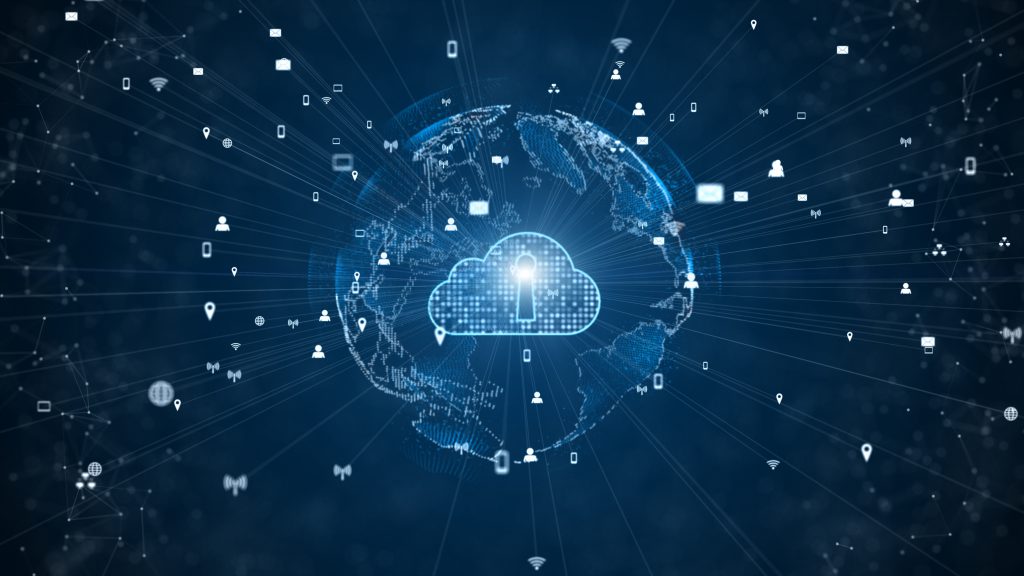Edge computing is transforming the way data is being handled, processed, and delivered from millions of devices around the world. With more internet-connected devices popping up every day through the Internet of Things (IoT) boom and new applications that require real-time computing power, the push for edge-computing systems is skyrocketing.
According to Gartner, in 2018, roughly 10% of enterprise-generated data was created and processed outside a traditional centralized data center or cloud. By 2025, they predict this figure will reach a whopping 75%. It’s definitely best to get in on the action now so you’re ready for the big push to the Edge. By leveraging the power of Edge Computing, companies prioritize both the employee and the customer experience when accessing applications and data.
But what is edge computing, and how does it impact you and your business? While the early goals of edge computing were to address the costs of bandwidth for data traveling long distances because of the growth of IoT-generated data, the rise of real-time applications that need processing at the edge will drive the technology ahead.
In this article, we will cover the edge computing definition, how it will affect you, and the primary benefits and factors you should consider.
What is Edge Computing?
A digital network is a transportation system for information. In this network, an “edge” consists of servers extended as far out as possible to reduce the time it takes for users to be expediently served. This model drives computer data storage towards a location where it is needed and supports mobile computing and IoT technologies.

Edge computing drives applications, data, and computing power services away from centralized points and towards places that are closer to the user. This is done so that data, especially real-time data, does not suffer latency issues that can affect an application’s performance.
In addition, companies can save money by having the processing done locally, reducing the amount of data that needs to be processed in a centralized or cloud-based location.
Edge computing was initially created because of the IoT growth, which connects to the internet for either receiving information from the cloud or sending data back to the cloud. While this is all taking place, enormous amounts of data are being created.
For a couple of examples of edge computing, think about the medical devices that are constantly tracking and updating patient information, or internet-connected security footage that is being sent from a remote location. While just one device producing data can transmit it across a network quite easily, problems arise when multiple devices transmit data at the same time. And, like mentioned earlier, new IoT devices are popping up all the time.
Imagine hundreds of doctors in a large hospital, pulling up or submitting patient data at the same time. Not only will these doctors experience latency, but the costs in bandwidth can be astronomical.
Edge Services
Edge computing services can help resolve the problems with latency and bandwidth. Data center colocation facilities can be a local source of processing and storage for many of these systems. An edge gateway can process data from a device and only send relevant data back, reducing bandwidth needs.
Although it may interact with a centralized cloud, edge computing does not require contact with a centralized cloud.
Edge computing allows for efficient data processing, specifically for large amounts of data to be processed near the source. This process reduces internet bandwidth use and costs, while also helps optimize application efficiency from remote locations.

Edge computing is an effort to bring the quality of service (QoS) back into the discussion of data center architecture and services, as enterprises decide not just WHO will provide their services, but also WHERE.
How Will Edge Computing Impact You?
For many companies, the cost savings alone can be a driver towards deploying an edge-computing architecture. For companies that have embraced the public cloud for many of their applications, they are discovering that costs were much higher than they expected.
A report on cloud repatriation by 451 Research stated that 20 percent of companies surveyed said cost drove them to move one or more of their workloads from public clouds to private clouds.
Increasingly though, the biggest benefit of edge computing is the ability to process and store data faster, enabling far more efficient real-time applications that are critical to companies.
“Edge computing has evolved significantly from the days of isolated IT at ROBO (Remote Office Branch Office) locations,” says Kuba Stolarski, a research director at IDC, in the Worldwide Edge Infrastructure (Compute and Storage) Forecast, 2019-2023 report. “With enhanced interconnectivity enabling improved edge access to more core applications, and with new IoT and industry-specific business use cases, edge infrastructure is poised to be one of the main growth engines in the server and storage market for the next decade and beyond.”
Here are a few examples of companies who felt like a move to the Edge was the best choice for them:
- A medical facility that was overwhelmed by the volume of data coming from medical devices tracking and updating patient information, security systems, and more. This information was being sent to a remote location and they were frequently overextending their bandwidth, leading to latency and network failure. By moving some of those critical operations to an Edge Computing model, they were able to reduce latency and improve overall network performance, regardless of how many IoT devices were generating data.
- A nuclear power plant was nervous about the response times of its sensors and potential outages in the event of a cyber-attack or natural disaster. By investing in Edge servers, they were able to ensure that their shut offs and security sensors would be less affected in the event of an outage, allowing them to continue operating safely as the issue is resolved.
- A financial organization was looking for a faster option to use in tandem with its public cloud that would keep its clients’ information secure and improve the slow network speeds that were causing delays in processing transactions. By introducing Edge servers to host their most critical and frequently accessed information, they were able to provide quicker service to their clients while upholding their compliance requirements.
What are the Benefits of Edge Computing?
This modern approach to network architecture has advantages that extend beyond delivering content and getting into the IoT market. Here are some of the top benefits that edge computing can bring businesses:
What are the Benefits of Edge Computing?
This modern approach to network architecture has advantages that extend beyond delivering content and getting into the IoT market. Here are some of the top benefits that edge computing can bring businesses:
Speed
For almost every business, speed is crucial to a successful operation. To continue using the healthcare example, for doctors that rely on high-frequency algorithms for patient care, a second of lag time could be a matter of life and death. Speed is no longer an advantage, it is a requirement.
Edge computing provides businesses with that requirement of speed. Data stream acceleration is enabled by edge computing, which includes real-time data processing without latency. This allows smart applications and devices to respond almost instantly while the data is being created. The large reduction of lag time has extensive benefits for technologies like self-driving cars and equally extensive benefits for businesses.
 This reduced latency can be measured in microseconds instead of milliseconds. If an additional moment of downtime can cost a company thousands of dollars, then the speed advantages of edge computing cannot be overlooked.
This reduced latency can be measured in microseconds instead of milliseconds. If an additional moment of downtime can cost a company thousands of dollars, then the speed advantages of edge computing cannot be overlooked.
Current commercial fiber-optic technology allows data to travel as fast as 2/3 the speed of light, moving from New York to San Francisco in about 21 milliseconds. While that sounds fast, it fails to consider the sheer amount of data being transmitted.
With the world expected to generate up to 44 zettabytes of data in 2020, digital traffic jams are almost guaranteed. To put that vast amount in perspective, one zettabyte equals a trillion gigabytes.
By processing data closer to the source and reducing the physical distance it must travel, edge computing can greatly reduce latency. The end result is higher speeds for end-users, with latency measured in microseconds rather than milliseconds. You’re not routing all traffic through one point, but rather creating specialized paths for each edge server. Instead of using and congesting one superhighway, you’re creating a more complex network of servers and paths to the cloud, allocating bandwidth as needed.
Security
While the proliferation of IoT edge computing devices does increase the overall attack surface for networks, it also provides some important security advantages.
Edge computing distributes processing, storage, and applications across a wide range of devices and data centers, which makes it difficult for any single disruption to take down the network.
Since more data is being processed on local devices, rather than transmitting it back to a central data center, edge computing also reduces the amount of data actually at risk at any one time.
A quality edge data center should offer a variety of tools clients can use to secure and monitor their networks in real time.
For example, LightEdge’s solutions are backed by one of the strongest service guarantees in the industry. Our support team is available 24 hours a day, 7 days a week – no exceptions. Our technical support starts with direct access to technicians in LightEdge’s Network Operations Center (NOC) via a toll-free number for emergencies.
The NOC experts also handle all formal monitoring, logging, and event management to ensure that pertinent information is recognized, identified, recorded, and processed promptly. This level of support is included with every LightEdge service and is designed to accommodate the unique needs of each customer.
Scalability
Many companies, try as they might, cannot anticipate their growth and IT infrastructure needs. The business may find a sudden boom of growth, or external causes may make for a slower year. It is almost impossible to predict with certainty.
Because of these costly and time-consuming obstacles, businesses started moving away from owning and operating data center facilities. According to a 451 Research survey of IT decision-makers on The Changing Landscape of Performance Monitoring, we continue to see businesses shifting to the cloud, with company-owned data centers slipping under 50 percent by 2020 as the primary IT environment.
Fortunately, the development of edge computing has made it easier than ever for businesses to scale their operations. Edge computing is a less expensive alternative to a dedicated data center that allows enterprises to grow their computing capability through the combination of IoT devices and edge data centers.
Edge data centers allow enterprises to efficiently support their end users with little physical distance or latency. For content providers that deliver uninterrupted streaming services, this benefit has substantial value. The use of processing-capable edge computing devices also reduces growth costs because each new device added does not impose substantial bandwidth demands on the core of a network.
Reliability
With better speed and security, comes better reliability. With IoT edge computing devices and edge data centers positioned closer to end users, there is less chance of a network problem in a distant location affecting local customers or businesses.
By processing data closer to the source and prioritizing traffic, edge computing reduces the amount of data flowing to and from the primary network, leading to lower latency and faster overall speed.
With so many edge computing devices and edge data centers connected to the network, it becomes much more difficult for any single failure to shut down service entirely.
Effectively incorporating IoT edge computing devices and edge data centers into a comprehensive IT architecture can therefore provide unparalleled reliability.
Does Edge Computing Compete with the Cloud?
While it can often sound like the Edge will act as a replacement to the cloud or it will force companies to choose, it really is the opposite. By leveraging both cloud and Edge technology, you have more flexibility and security and can prioritize speeds for critical functions and applications. Think of the route from the cloud to the end user as a trek up and down a mountain. The Edge server can act like an outpost where there is less distance from the end user to mission critical information.
For example, a chemical plant choosing to utilize the Edge and the cloud concurrently will likely elect to keep their HR policies in the cloud but then have their plant sensors routed through the Edge, so in the event of an emergency the auto shut-offs will be able to deploy faster – saving money, property damage, and likely human lives. If they were to rely solely on the cloud for these technologies, it’s entirely possible that help might arrive too late. There is a place for both the cloud and the Edge in most companies, it’s just a matter of understanding where and how to use each one.
LightEdge is Running on the Edge
As a top-tier colocation services provider, we provide a high level of availability and reliability through secure, certified data centers and dedicated staff onsite. Our customized and scalable services give you the control, whether you need a colocation rack, cage or custom suite now or in the future.
When asked about our differentiators against the competition, one of the first answers is always – our network. Our history with the network goes back to 1996 when we were founded as an ISP. We spent over two decades making sure our network and infrastructure were scalable, redundant, and secure enough to meet the most challenging IT needs.
From a dedicated physical infrastructure to a virtual delivery model, we’ve got the compliant cloud and hosting solution for your organization. Retain the level of control you want, and the amount of data isolation you require.
LightEdge offers a free risk assessment from our Chief Security Officer as a free resource to all of our clients. LightEdge’s highly trained compliance and network security experts take the guesswork out of keeping your business protected. LightEdge’s top priorities include compliance and network security to guarantee that our customer’s data is protected. LightEdge is compliant with:
Have you heard enough? Reach out to one of our LightEdge Network Experts today at info@lightedge.com or call 1-877-771-3343.
We have empowered hundreds of organizations across the nation through improved latency, security, and reliability. We are ready to do the same for you.




